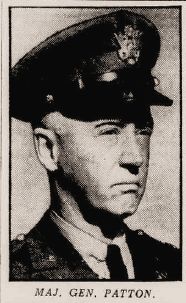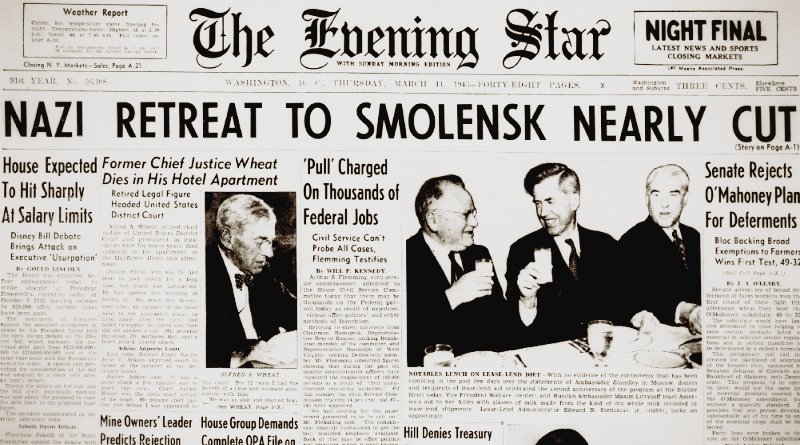World War II Chronicle: March 11, 1943
Click here for TODAY’S NEWSPAPER

The front page reports that over 2,000 American troops were reported as missing in action in one week of fighting in Tunisia last month… Major Generals Carl A. Spaatz and George S. Patton Jr. are each about to pin on a third star (see page two)… Page three has more on the shipwrecked crew of SS Zaandam, who survived 83 days drifting in the Atlantic Ocean…
George Fielding Eliot column on page 14… Sports begin on page 20, including a Grantland Rice column on recreational golf…
Roving Reporter by Ernie Pyle
A FORWARD TUNISIAN AIRDROME — Everything around a fighter-bomber airdrome is important, but I know of nothing more important than the repair section.
It’s vastly different from airplane shops or garages back home, where nothing more than a little inconvenience results from the long layup of a plane or car.
Out here there are just so many planes. With us and Germany teeter-tottering for air superiority over Africa, every single one is as precious as though it were made of gold. Every plane out of action is temporarily the same as a plane destroyed.
It is the job of the repair section to take the shot-up planes and get them back into the air a little faster than is humanly possible. And that is what they are doing.
At our desert airdrome this section is in charge of Major Charles E. Coverley, of Palo Alto, Calif. His nickname is “Erk,” and he was one of my fellow-travelers from England.
His right arm is a quiet mechanical genius named Walter Goodwin, of Grove City, Pa. — a regular Army sergeant, just promoted on the field to warrant officer. The men worship him and every officer on the field accepts his judgment on plane damage as final.
The repair action operates under a theory that seems outlandish after coming from the peacetime business world. Its motto is to give away everything it can.
Instead of hoarding their supplies and yelling that they’re snowed-under with work, they go around the field accepting every job imaginable, fulfilling every pilot’s request, donating from their precious small stock of spare parts to any line mechanic that asks for something. For only by doing it that way do planes get back in the air a few hours sooner.
In the repair section are 250 master craftsmen. They are happy and sincere and proud. I’ve never seen a greater willingness to work beyond all requirements than these men show.
Let me give you an example of how the section works. After a recent little to-do with the enemy, 14 of our planes were found to be damaged. Some needed only skin patches; others had washtub holes through the wings and were almost rebuilding jobs.
Maj. Coverley and the squadron engineers surveyed the situation all morning, driving in a jeep from one plane to another. I rode with them, and when noon came and not a plane had been moved over to the repair area, I thought to myself this is a mighty slow way to win a war. But I changed my mind a little later.
It takes that long to estimate all the damage, plan out your program, distribute your men and machines over the huge field, and get things rolling. But once rolling —
Two days later I checked on their progress. Five of those wrecked planes were ready for missions by that first evening. Three more were delivered the following day. On the third day four more were just about finished. That makes 12. The other two had been turned into salvage, for spare parts.
Under peacetime conditions at home, it would have taken perhaps two months even in the finest shops to get all those planes in the air. But here they were fighting again within three days. You can do the impossible when you have to.
This field operates with a dearth of spare parts, as probably do all our fields at the far ends of the earth. So the field provides its own spare parts by scrapping the most badly damaged planes, and using the good parts that are left.
This happens to about of one of every 15 planes that are shot up. These condemned planes are towed to the engineering section, and they gradually disappear. Finally they are skeletons — immobile, pathetic skeletons, picked bare by the scavenging mechanics.
These salvage planes are nicknamed “hangar queens.” Five of them are sitting on the line now. As you know, every bomber has a name painted on its nose. One of these hangar queens is called “Fertile Myrtle.” Another is “Special Delivery.” And a third is “Little Eva,” which happens also to be the nickname of a friend of mine in Albuquerque.
The Little Eva of Albuquerque spends her life raising flowers and being nice to other people; the Little Eva of Africa has given her life that other planes may fly on to help end the war.
You’d be touched by the sight of the repair shops here. All plane work is done right out doors. The only shops are tents where small machine work is done.
The tents are three-sided, with one end open. The floor is sand. When the wind blows the men have to wear goggles. Beside every tent, almost within one-jump distance, is a deep slit trench to dive into when the enemy bombers come.
Theirs is real war work, and you can’t say they’re much safe than the airmen themselves, for they are subject to frequent bombing.
They say their main hope is that no experts from the factories back home show up to look things over. The experts would tell them a broken wing can’t be fixed that way. But these birds know damn well it can be, for they’re doing it.
Evening star. (Washington, D.C.), 11 March 1943. Chronicling America: Historic American Newspapers. Lib. of Congress.
https://chroniclingamerica.loc.gov/lccn/sn83045462/1943-03-11/ed-1/
